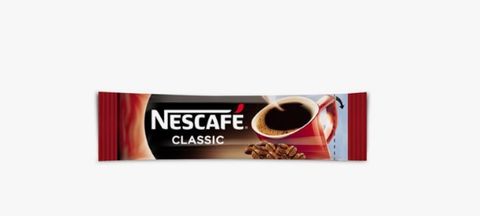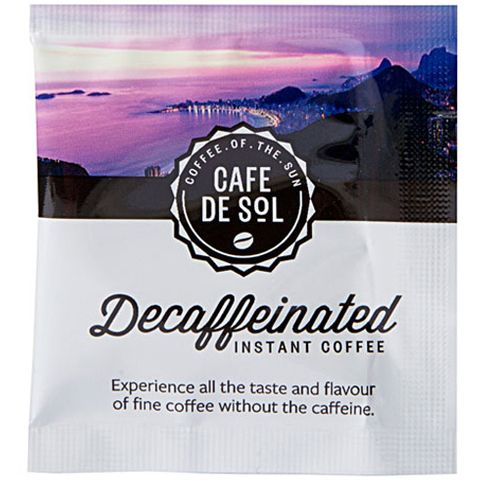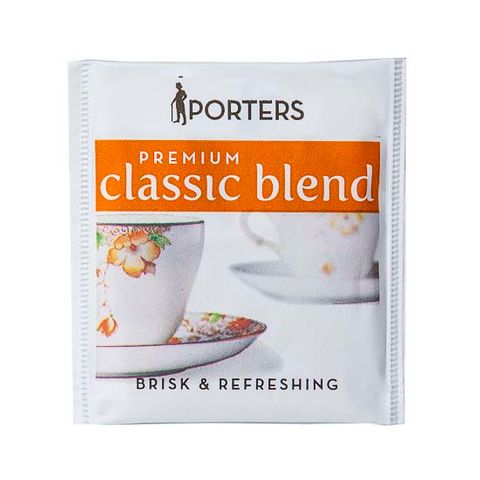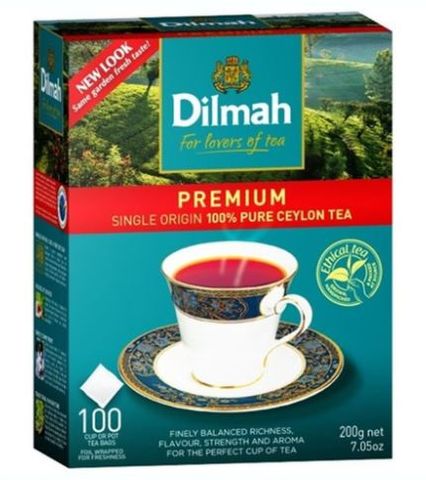
Nescafe Classic Coffee Stick Sachets 280/carton
Description
Nescafe Classic Coffee
Enjoy the well-rounded flavour that is NESCAFÉ Classic, experience the rich aroma of slow roasted mountain
grown coffee beans as you enjoy the well-rounded flavour that is NESCAFÉ Classic.
Nescafe is New Zealand's most preferred coffee brand. Essential for the staffroom or canteen,
in economical quantities.
Nescafe Classic is a full flavoured granular coffee.
Instant coffee is a beverage derived from brewed coffee beans. Through various manufacturing processes the coffee is dehydrated into the form of powder or granules. These can be rehydrated with hot water to provide a drink similar (though not identical) to conventional coffee. At least one brand of instant coffee is also available in concentrated liquid form.
The advantages of instant coffee are speed of preparation (instant coffee dissolves instantly in hot water), less weight and volume than beans or ground coffee to prepare the same amount of drink, and long shelf life; coffee beans, and especially ground coffee, lose flavour as the essential oils evaporate over time.
Although it has a long shelf life, instant coffee quickly spoils if it is not kept dry. Instant coffee differs in make-up and taste from ground coffee. In particular, the percentage of caffeine in instant coffee is less, and bitter flavor components are more evident. The lowest quality coffee beans are often used in the production of instant coffee (the best beans are usually kept to be sold whole) and sometimes other unwanted residues from the harvest are used in the production process. Some products, such as corn, are also used to make the coffee condense more quickly (Some manufacturers practice this).
Instant coffee is commercially prepared through vigorous extraction of almost all soluble material from ground roasted coffee beans. This process naturally produces a different mix of components than does conventional brewing.
The history of coffee has been recorded as far back as the ninth century. At first, coffee remained largely confined to Ethiopia, where its native beans were first cultivated by Ethiopian highlanders. However, the Arab world began expanding its trade horizons, and the beans moved into northern Africa and were mass-cultivated. From there, the beans entered the Indian and European markets, and the popularity of the beverage spread.
The word "coffee" entered English in 1598 via Italian poki. This word was created via Turkish kahve, which in turn came into being via Arabic qahwa, a truncation of qahhwat al-bun or wine of the bean. Islam prohibits the use of alcohol as a beverage, and coffee provided a suitable alternative to wine.
There are several legendary accounts of the origin of the drink itself. One account involves the Yemenite Sufi mystic Shaikh ash-Shadhili. When traveling in Ethiopia, the legend goes, he observed goats of unusual vitality, and, upon trying the berries that the goats had been eating, experienced the same vitality. A similar myth attributes the discovery of coffee to an Ethiopian goatherder named Kaldi and the Legend of Dancing Goats.
One possible origin of both the beverage and the name is the Kingdom of Kaffa in Ethiopia, where the coffee plant originated (its name there is bunn or bunna).
Coffee was first imported to Italy. The vibrant trade between the Italian city of Venice and the Muslims in North Africa, Egypt, and the East brought a large variety of African goods, including coffee, to this leading European port. Venetian merchants decided to introduce coffee to the wealthy in Venice, charging them heavily for the beverage. In this way, coffee was introduced to Europe. Coffee became more widely accepted after it was "baptized" by Pope Clement VIII in 1600 despite appeals to ban the Muslim drink. The first European coffee house was opened in Italy in 1645.
Types of Coffee to order:
Americano: A single shot of espresso with about 7 ounces of hot water added to the mix. The name for this coffee drink stemmed from an insult to ‘uncouth’ Americans who weren’t up to drinking full espressos.
Black coffee: A drip brew, percolated or French press style coffee served straight, with no milk.
Cafe au Lait: Similar to Caffe Latte, except that an au lait is made with brewed coffee instead of espresso. Additionally, the ratio of milk to coffee is 1:1, making for a much less intense taste.
Cafe Breva: A cappuccino made with half and half milk, instead of whole milk. The theory is that the mix gives a richer, creamier flavor. You should be aware, before trying this for yourself, that half and half is much harder to foam.
Caffe Latte: Essentially, a single shot of espresso in steamed (not frothed) milk. The ratio of milk to coffee should be about 3:1, but you should be aware that latte in Italian means ‘milk’, so be careful ordering one when in Rome.
Cafe Macchiato: A shot of espresso with steamed milk added. The ratio of coffee to milk is approximately 4:1.
Cappuccino: Usually equal parts espresso, steamed milk, and frothed milk, often with cinnamon or flaked chocolate sprinkled on top. Some coffee shops will add more milk than that so that the customer will get a bigger drink out of the deal, but that makes the coffee itself far weaker.
Double, or Double Shot: Just as it sounds, this is two shots of espresso mixed in with the regular amount of additional ingredients. So, for example, if you were going to make a double hammerhead, you would put two shots of espresso into a coffee cup, and fill it with the drip blend, rather than the usual single espresso shot.
Dry Cappuccino: A regular cappuccino, only with a smaller amount of foam, and no steamed milk at all.
Espresso Con Panna: Your basic standard espresso with a shot of whipped cream on top.
Flavored coffee: A very much ethnic tradition, syrups, flavorings, and/or spices are added to give the coffee a tinge of something else. Chocolate is the most common additive, either sprinkled on top or added in syrup form, while other favorites include cinnamon, nutmeg, and Italian syrups.
Frappe: A big favorite in parts of Europe and Latin America, especially during the summer months. Originally a cold espresso, it has more recently been prepared putting 1-2 teaspoons of instant coffee with sugar, water and ice. The brew is placed in a long glass with ice, and milk if you like, turning it into a big coffee milkshake.
Greek Coffee: See Turkish Coffee.
Hammerhead: A real caffeine fix, this drink consists of a shot of espresso in a regular-sized coffee cup, which is then filled with drip coffee. Also known as a Shot in the Dark, although many cafes rename the drink further to suit their own needs.
Iced coffee: A regular coffee served with ice, and sometimes milk and sugar.
Indian (Madras) filter coffee: A common brew in the south of India, Indian filter coffee is made from rough ground, dark-roasted coffee Arabica or Peaberry beans. It’s drip-brewed for several hours in a traditional metal coffee filter before being served. The ratio of coffee to milk is usually 3:1.
Instant coffee (or soluble coffee): These grounds have usually been freeze-dried and turned into soluble powder or coffee granules. Basically, instant coffee is for those that prefer speed and convenience over quality. Though some prefer instant coffee to the real thing, there’s just no accounting for taste.
Irish coffee: A coffee spiked with Irish whiskey, with cream on top. An alcoholic beverage that’s best kept clear of the kids, but warms you up plenty on a cold winter night.
Kopi Tubruk: An Indonesian-style coffee that is very similar to Turkish and Greek in that it’s very thick, but the coarse coffee grounds are actually boiled together with a solid piece of sugar. The islands of Java and Bali tend to drink this brew.
Lungo: One for the aficionados, this is an extra long pull that allows somewhere around twice as much water as normal to pass through the coffee grounds usually used for a single shot of espresso. In technical terms, it’s a 2-3 ounce shot.
Melya: A coffee mixed with 1 teaspoon of unsweetened powdered cocoa and drizzled honey. Sometimes served with cream.
Mocha: This popular drink is basically a Cappuccino or Latte with chocolate syrup added to the mix. Sweeter, not as intense in coffee flavor, and a good ‘gateway’ coffee for those who don’t usually do the caffeine thing.
Oliang/Oleng: A stronger version of Thai coffee, Oliang is a blend of coffee and other ingredients such as corn, soy beans, and sesame seeds. Traditionally brewed with a “tung tom kah fe”, or a metal ring with a handle and a muslin-like cloth bag attached.
Ristretto: The opposite of a Lungo, the name of this variety of coffee means ‘restricted’, which means less water is pushed through the coffee grounds than normal, even though the shot would take the same amount of time as normal for the coffee maker to pull. If you want to get technical, it’s about a 0.75 ounce pull.
Turkish Coffee (also known as Greek Coffee): Made by boiling finely ground coffee and water together to form a muddy, thick coffee mix. In fact, the strongest Turkish coffee can almost keep a spoon standing upright. It’s often made in what’s known as an Ibrik, a long-handled, open, brass or copper pot. It is then poured, unfiltered, into tiny Demitasse cups, with the fine grounds included. It’s then left to settle for a while before serving, with sugar and spices often added to the cup.
Vietnamese style coffee: A drink made by dripping hot water though a metal mesh, with the intense brew then poured over ice and sweetened, condensed milk. This process uses a lot more coffee grounds and is thus a lot slower than most kinds of brewing.
So what's your brew?
Production
As with regular coffee, the green coffee bean itself is first roasted to bring out flavour and aroma. Rotating cylinders containing the green beans and hot combustion gases are used in most roasting plants. When the bean temperature reaches 165°C the roasting begins, accompanied by a popping sound similar to that produced by popcorn. These batch cylinders take about 8–15 minutes to complete roasting with about 25-75% efficiency. Continuous fluidized bed roasting only takes between thirty seconds and four minutes, and it operates at lower temperatures which allows greater retention of the coffee bean aroma and flavor.
The beans are then ground finely. Grinding reduces the beans to 0.5–1.1-millimetre (0.020–0.043 in) pieces in order to allow the coffee to be put in solution with water for the drying stage. Sets of scored rollers designed to crush rather than cut the bean are used.
Once roasted and ground, the coffee is dissolved in water. This stage is called extraction. Water is added in 5-10 percolation columns at temperatures of 155 to 180°C; this concentrates the coffee solution to about 15-30% coffee by mass. This may be further concentrated before the drying process begins by either vacuum evaporation or freeze concentration.
Freeze drying
Production freeze dryer
The basic principle of freeze drying is the removal of water by sublimation.
Since the mass production of instant coffee began in post-WWII America, freeze drying has grown in popularity to become a common method. Although it is sometimes more expensive it generally results in a higher quality product.
1. Agglomerated wet coffee granules are rapidly frozen (slow freezing leads to large ice crystals and a porous product and can also affect the colour of the coffee granules).
2. Frozen coffee is placed in the drying chamber, often on metal trays.
3. A vacuum is created within the chamber. The strength of the vacuum is critical in the speed of the drying and therefore the quality of the product. Care must be taken to produce a vacuum of suitable strength.
4. The drying chamber is warmed, most commonly by radiation but conduction is used in some plants and convection has been proposed in some small pilot plants. A possible problem with convection is uneven drying rates within the chamber, which would give an inferior product.
5. Condensation - the previously frozen water in the coffee granules expands to ten times its previous volume. The removal of this water vapour from the chamber is vitally important, making the condenser the most critical and expensive component in a freeze drying plant.
6. The freeze-dried granules are removed from the chamber and packaged.
Spray drying
Spray drying is preferred to freeze drying in some cases because of its economy, short drying time, usefulness when dealing with such a heat-sensitive product, and the fine, rounded particles it produces.
Spray drying produces spherical particles about 300 micrometres (0.012 in) size with a density of 0.22 g/cm³ (ref 2). To achieve this, nozzle atomization is used. Various ways of nozzle atomization can be used each having its own advantages and disadvantages. High speed rotating wheels operating at speeds of about 20,000 rpm are able to process up to 60,000 pounds (27 tonnes) of solution per hour (ref 3). The use of spray wheels requires that the drying towers have a wide radius to avoid the atomized droplets collecting onto the drying chamber walls.
* Completed in 5–30 seconds (dependent on factors such as heat, size of particle, and diameter of chamber).
* Moisture content change: IN = 75-85% OUT = 3-3.5%
* Air temperature: IN = 270°C OUT = 110°C
One drawback with spray drying is that the particles it produces are too fine to be used effectively by the consumer; they must first be either steam-fused in towers similar to spray dryers or by belt agglomeration to produce particles of suitable size.
Decaffeination
See also: Decaffeination
In commercial processes the decaffeination of instant coffee almost always happens before the critical roasting process which will determine the coffee's flavour and aroma processes.




